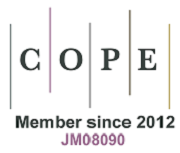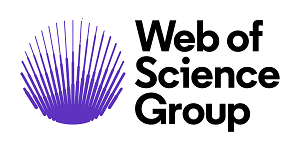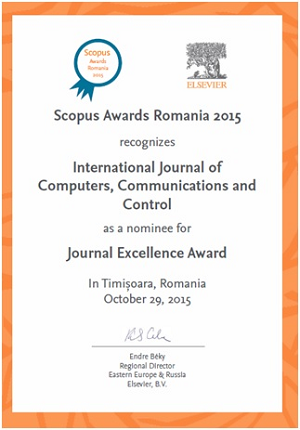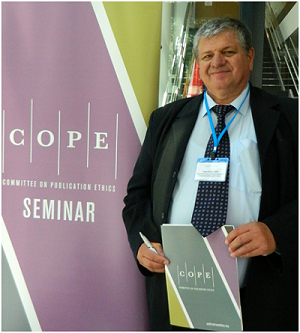Energy Optimization for WSN in Ubiquitous Power Internet of Things
Keywords:
Ubiquitous power Internet of Things (UPIoT), energy-balanced routing, rechargeable wireless rechargeable network (WSN), routing algorithm, low power modeAbstract
This paper attempts to solve the problems of uneven energy consumption and premature death of nodes in the traditional routing algorithm of rechargeable wireless sensor network in the ubiquitous power Internet of things. Under the application environment of the UPIoT, a multipath routing algorithm and an opportunistic routing algorithm were put forward to optimize the network energy and ensure the success of information transmission. Inspired by the electromagnetic propagation theory, the author constructed a charging model for a single node in the wireless sensor network (WSN). On this basis, the network energy optimization problem was transformed into the network lifecycle problem, considering the energy consumption of wireless sensor nodes. Meanwhile, the traffic of each link was computed through linear programming to guide the distribution of data traffic in the network. Finally, an energy optimization algorithm was proposed based on opportunistic routing, in a more realistic low power mode. The experimental results show that the two proposed algorithms achieved better energy efficiency, network lifecycle and network reliability than the shortest path routing (SPR) and the expected duty-cycled wakeups minimal routing (EDC). The research findings provide a reference for the data transmission of UPIoT nodes.References
Asha, G.; Santhosh, R. (2019). Soft computing and trust-based self-organized hierarchical energy balance routing protocol (TSHEB) in wireless sensor networks, Soft Computing, 23(8), 2537-2543, 2019. https://doi.org/10.1007/s00500-018-03704-7
Awad, F.H. (2018). Optimization of relay node deployment for multisource multipath routing in Wireless Multimedia Sensor Networks using Gaussian distribution, Computer Networks, 145, 96-106, 2018. https://doi.org/10.1016/j.comnet.2018.08.021
Caria, M.; Jukan, A.; Hoffmann, M. (2016). SDN partitioning: A centralized control plane for distributed routing protocols, IEEE Transactions on Network and Service Management, 13(3), 381-393, 2016. https://doi.org/10.1109/TNSM.2016.2585759
Chen, Y.; Xu, X.G.; Wang, Y. (2019). Wireless sensor network energy efficient coverage method based on intelligent optimization algorithm, Discrete and continuous dynamical systems-series, 12(4-5), 887-900, 2019. https://doi.org/10.3934/dcdss.2019059
Chen, Z.G.; Yin, B.A.; Wu, J. (2018). Message of the importance of the opportunity to network based energy equilibrium routing algorithm, Journal of communication, 39(12), 91-101, 2018.
Chowdhury, S.; Giri, C. (2019). Energy and Network Balanced Distributed Clustering in Wireless Sensor Network, Wireless Personal Communications, 105(3), 1083-1109, 2019. https://doi.org/10.1007/s11277-019-06137-z
Ghazi, A.E.; Ahiod, B. (2018). Energy efficient teaching-learning-based optimization for the discrete routing problem in wireless sensor networks, Applied Intelligence, 48(9), 2755-2769, 2018. https://doi.org/10.1007/s10489-017-1108-8
Gu, Y.; He, T. (2011); Dynamic switching-based data forwarding for low-duty-cycle wireless sensor networks, IEEE Transactions on Mobile Computing, 10(12), 1741-1754, 2011. https://doi.org/10.1109/TMC.2010.266
Habib, M. (2019). Energy-Efficient algorithm for reliable routing of wireless sensor networks, IEEE Transactions on Industrial Electronics, 66(7), 5567-5575, 2019. https://doi.org/10.1109/TIE.2018.2869345
Jayanthi, N.; Valluvan, K.R. (2018). Bio-inspired optimization routing technique using DNA sequencing algorithm for wireless sensor networks, Wireless Personal Communications, 101(4), 2365-2381, 2018. https://doi.org/10.1007/s11277-018-5821-3
Khan, I.; Singh, D. (2018). Energy-balance node-selection algorithm for heterogeneous wireless sensor networks, Electronics Journal, 40(5), 604-612, 2018. https://doi.org/10.4218/etrij.2017-0349
Kulshrestha, J.; Mishra, M.K. (2018). Energy balanced data gathering approaches in wireless sensor networks using mixed-hop communication, Computing, 100(10), 1033-1058, 2018. https://doi.org/10.1007/s00607-018-0597-6
Lee, J.; Kao, T. (2016). An improved three-layer low-energy adaptive clustering hierarchy for wireless sensor networks, IEEE Internet of Things Journal, 3(6), 951-958, 2016. https://doi.org/10.1109/JIOT.2016.2530682
Liu, C. (2015). Cluster head election strategy based on LEACH protocol in WSN routing algorithm and research, Hangzhou university of electronic science and technology.
Liu, X.T.; Chen, Z.P.; Huang, Y.Y. (2019). A non-uniform clustering routing algorithm based on energy equilibrium, Microelectronics and computer, 36(2), 36-40, 2019.
Liu, Y.; Wu, Y.; Chang, J. (2019). The diffusion clustering scheme and hybrid energy balanced routing protocol (DCRP) in multi-hop wireless sensor networks, AD HOC and Sensor Wireless Networks, 43(1-2), 33-56, 2019.
Mittal, N. (2019). Moth flame optimization based energy efficient stable clustered routing approach for wireless sensor networks, Wireless Personal Communications, 104(2): 677-694, 2019. https://doi.org/10.1007/s11277-018-6043-4
Shalabi, M.; Anbar, M.; Wan, T.; Khasawneh, A. (2018). Variants of the low-energy adaptive clustering hierarchy protocol: Survey, Issues and Challenges, Electronics, 7(8), 136, 2018. https://doi.org/10.3390/electronics7080136
Sun, Z.; Wei, M.; Zhang, Z. (2019). Secure routing protocol based on multi-objective antcolony- optimization for wireless sensor networks, Applied Soft Computing, 77, 366-375, 2019. https://doi.org/10.1016/j.asoc.2019.01.034
Tabibi, S.; Ghaffari, A. (2019). Energy-efficient routing mechanism for mobile sink in wireless sensor networks using particle swarm optimization algorithm, Wireless Personal Communications, 104(1), 199-216, 2019. https://doi.org/10.1007/s11277-018-6015-8
Xia, X.J.; Li, S.N.; Zhang, Y. (2015). Energy of mixed data transmission in one-dimensional sensor network Equilibrium, Journal of Software, 26(8), 1983-2006, 2015.
Xiao, K.; Wang, R.; Deng, H. (2019). Energy-aware scheduling for information fusion in wireless sensor network surveillance, Information Fusion, 48, 95-106, 2019. https://doi.org/10.1016/j.inffus.2018.08.005
Published
Issue
Section
License
ONLINE OPEN ACCES: Acces to full text of each article and each issue are allowed for free in respect of Attribution-NonCommercial 4.0 International (CC BY-NC 4.0.
You are free to:
-Share: copy and redistribute the material in any medium or format;
-Adapt: remix, transform, and build upon the material.
The licensor cannot revoke these freedoms as long as you follow the license terms.
DISCLAIMER: The author(s) of each article appearing in International Journal of Computers Communications & Control is/are solely responsible for the content thereof; the publication of an article shall not constitute or be deemed to constitute any representation by the Editors or Agora University Press that the data presented therein are original, correct or sufficient to support the conclusions reached or that the experiment design or methodology is adequate.







